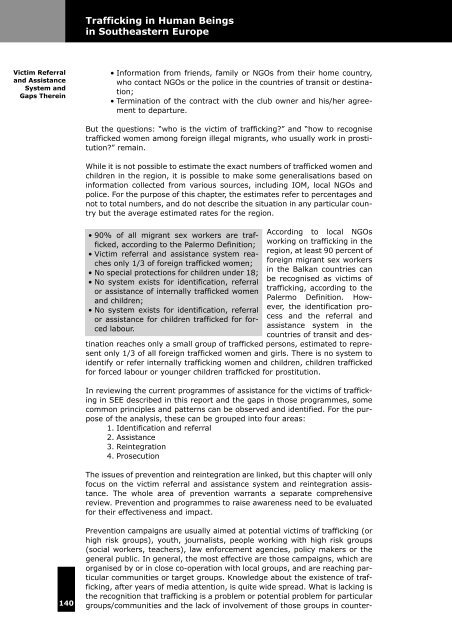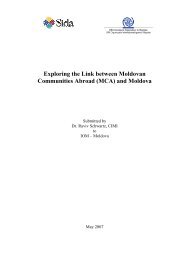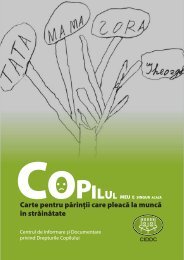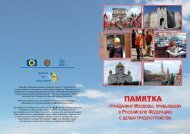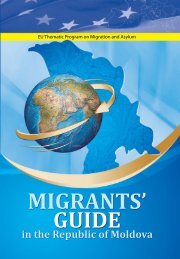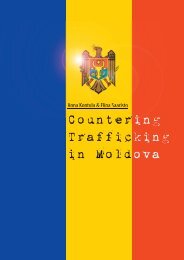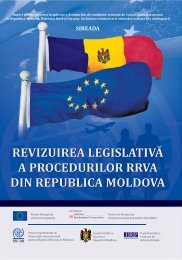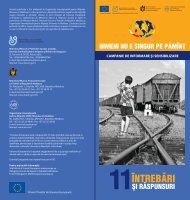Trafficking in Human Beings in Southeastern Europe - Iom
Trafficking in Human Beings in Southeastern Europe - Iom
Trafficking in Human Beings in Southeastern Europe - Iom
- No tags were found...
You also want an ePaper? Increase the reach of your titles
YUMPU automatically turns print PDFs into web optimized ePapers that Google loves.
<strong>Traffick<strong>in</strong>g</strong> <strong>in</strong> <strong>Human</strong> Be<strong>in</strong>gs<strong>in</strong> <strong>Southeastern</strong> <strong>Europe</strong>Victim Referraland AssistanceSystem andGaps There<strong>in</strong>• Information from friends, family or NGOs from their home country,who contact NGOs or the police <strong>in</strong> the countries of transit or dest<strong>in</strong>ation;• Term<strong>in</strong>ation of the contract with the club owner and his/her agreementto departure.But the questions: “who is the victim of traffick<strong>in</strong>g?” and “how to recognisetrafficked women among foreign illegal migrants, who usually work <strong>in</strong> prostitution?”rema<strong>in</strong>.While it is not possible to estimate the exact numbers of trafficked women andchildren <strong>in</strong> the region, it is possible to make some generalisations based on<strong>in</strong>formation collected from various sources, <strong>in</strong>clud<strong>in</strong>g IOM, local NGOs andpolice. For the purpose of this chapter, the estimates refer to percentages andnot to total numbers, and do not describe the situation <strong>in</strong> any particular countrybut the average estimated rates for the region.• 90% of all migrant sex workers are trafficked,accord<strong>in</strong>g to the Palermo Def<strong>in</strong>ition;• Victim referral and assistance system reachesonly 1/3 of foreign trafficked women;• No special protections for children under 18;• No system exists for identification, referralor assistance of <strong>in</strong>ternally trafficked womenand children;• No system exists for identification, referralor assistance for children trafficked for forcedlabour.Accord<strong>in</strong>g to local NGOswork<strong>in</strong>g on traffick<strong>in</strong>g <strong>in</strong> theregion, at least 90 percent offoreign migrant sex workers<strong>in</strong> the Balkan countries canbe recognised as victims oftraffick<strong>in</strong>g, accord<strong>in</strong>g to thePalermo Def<strong>in</strong>ition. However,the identification processand the referral andassistance system <strong>in</strong> thecountries of transit and dest<strong>in</strong>ationreaches only a small group of trafficked persons, estimated to representonly 1/3 of all foreign trafficked women and girls. There is no system toidentify or refer <strong>in</strong>ternally traffick<strong>in</strong>g women and children, children traffickedfor forced labour or younger children trafficked for prostitution.In review<strong>in</strong>g the current programmes of assistance for the victims of traffick<strong>in</strong>g<strong>in</strong> SEE described <strong>in</strong> this report and the gaps <strong>in</strong> those programmes, somecommon pr<strong>in</strong>ciples and patterns can be observed and identified. For the purposeof the analysis, these can be grouped <strong>in</strong>to four areas:1.Identification and referral2.Assistance3.Re<strong>in</strong>tegration4.ProsecutionThe issues of prevention and re<strong>in</strong>tegration are l<strong>in</strong>ked, but this chapter will onlyfocus on the victim referral and assistance system and re<strong>in</strong>tegration assistance.The whole area of prevention warrants a separate comprehensivereview. Prevention and programmes to raise awareness need to be evaluatedfor their effectiveness and impact.140Prevention campaigns are usually aimed at potential victims of traffick<strong>in</strong>g (orhigh risk groups), youth, journalists, people work<strong>in</strong>g with high risk groups(social workers, teachers), law enforcement agencies, policy makers or thegeneral public. In general, the most effective are those campaigns, which areorganised by or <strong>in</strong> close co-operation with local groups, and are reach<strong>in</strong>g particularcommunities or target groups. Knowledge about the existence of traffick<strong>in</strong>g,after years of media attention, is quite wide spread. What is lack<strong>in</strong>g isthe recognition that traffick<strong>in</strong>g is a problem or potential problem for particulargroups/communities and the lack of <strong>in</strong>volvement of those groups <strong>in</strong> counter-


